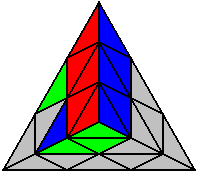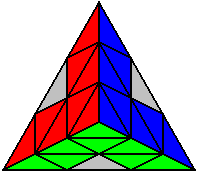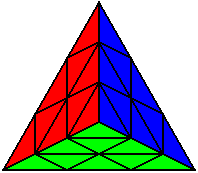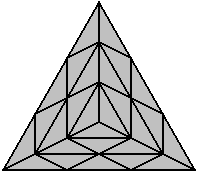Half Backbone
Half Backbone is a recent idea I had for Pyraminx solving. It's based around the older idea of Petrus, which was based around the 3x3x3 method, and solved a block, then oriented the 5 edges, and finally permuted them with intuition only. Since then, a related method called Backbone developed, where you oriented the 5 edges while making the initial block, and then finished the same way as Petrus. This method is an attempt to improve on both methods by fixing some of the problems: orienting 5 edges is tough, and permuting 5 edges is also very hard to do quickly and intuitively.
Note that this method doesn't specify when to do the trivial tips - there's no obvious place for them to go, so if you're going to use this method you should try to fit them in whenever you feel is most comfortable.
The first step of this method is somewhat tricky, but not too hard to figure out in inspection with a little practice. The idea is to solve a "backbone" (two corners solved along with the edge in between), while also making sure two specific edges are oriented. Those two edges must be the other two edges around one of the corners of the backbone (so you have two choices for which edges to use). Notice that once the backbone is solved, two corners are free (let's call them L and R); an edge is considered oriented if it could be solved with L and R moves alone. You can flip an edge using a move such as U L U'.
Personally, I find it hard to check all of this at once, so when I use this method my first step is to figure out a backbone solution - usually this is a small number of moves. Then, still in inspection, I will check which (if any) of the two edges needs to be flipped, and then add moves in the middle or at the end of my backbone solution to fix that. If you make a mistake and the edges aren't both properly oriented, you can always fix them afterwards, although it will cost you time.
Remember how the two edges were oriented so they could be solved with only L and R moves? Your next step is to actually solve them, again using only L and R moves. The basic strategy here is to first pair the edges up with the L/R corners, and then move the edges into position.
The remaining three edges are on the same face, so you can finish with the very very fast ELL step. Algorithms can be found on the SpeedSolving wiki, if you don't already know them.




